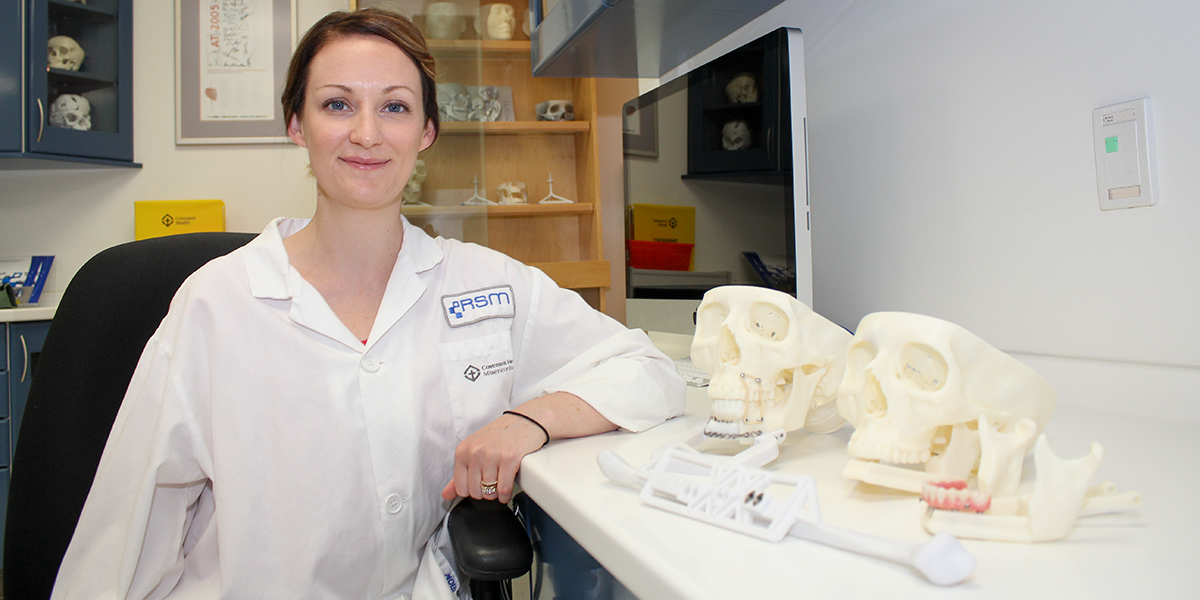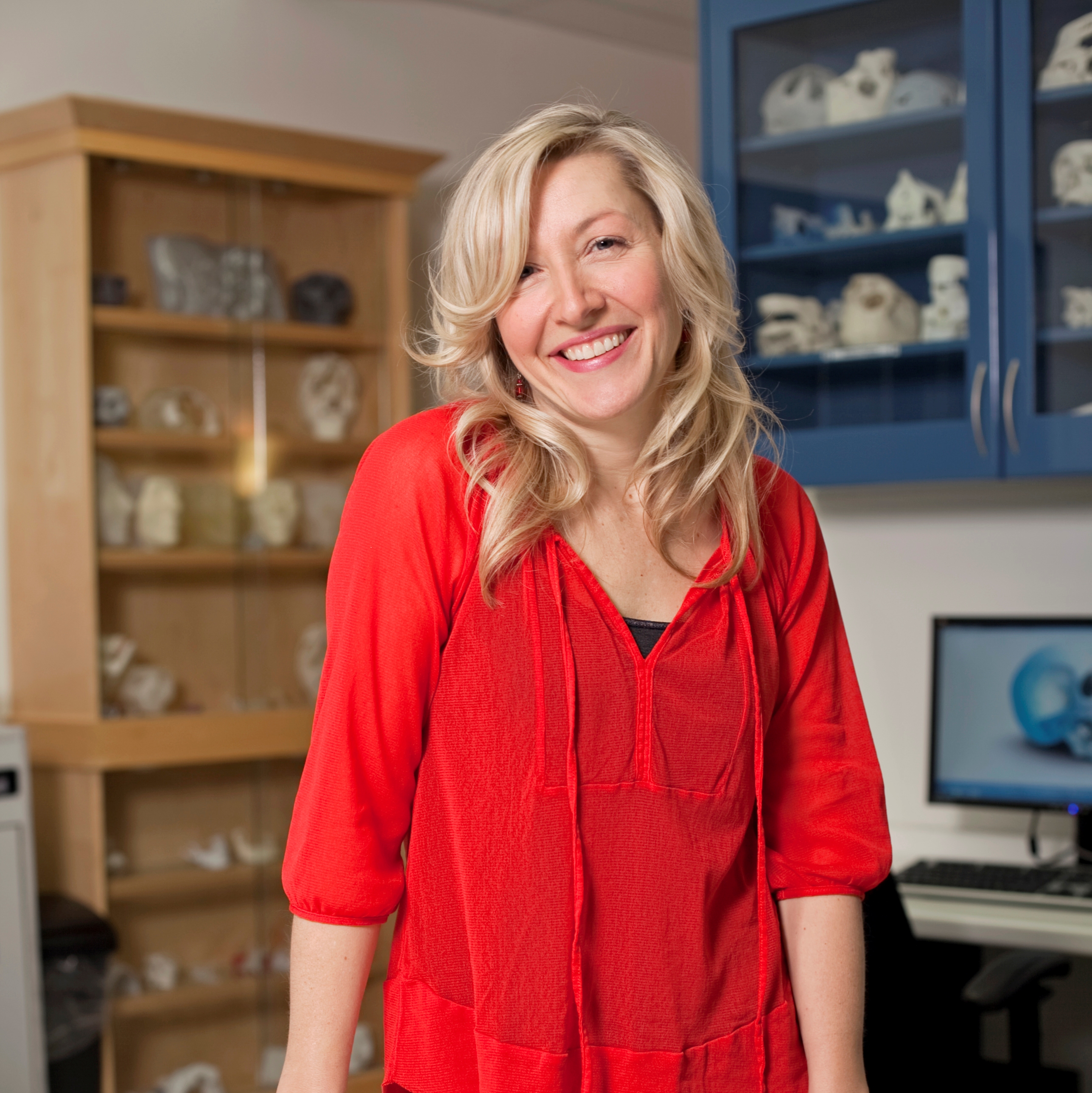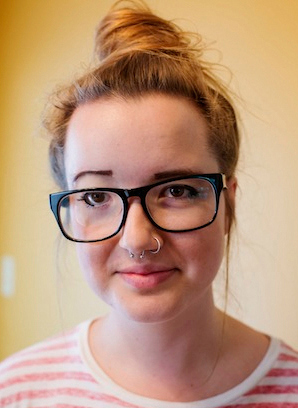
Heather Logan became the first person to complete a master's in rehabilitation science, specializing in surgical design and simulation, when she graduated from the U of A in 2011. Logan now works at the Institute for Reconstructive Sciences in Medicine where she creates 3-D patient models to help with reconstructive surgery. (Photo: Bryan Alary)
(Edmonton) Surgeons have traditionally relied on experience and judgment to shape the bones of people requiring jaw reconstruction. Often the surgeons don't know what to expect until the patient is opened up on the table, and then it requires great skill by the surgeon to determine how to design the jaw at the operating table.
"When a bone is not in an optimal position, we can't get the teeth to match up and the jaw doesn't rotate the way it should, that tells us that there should be a better method," says Jana Rieger, a professor at the University of Alberta's Faculty of Rehabilitation Medicine and director of research with the Institute for Reconstructive Sciences in Medicine (iRSM).
Some 4,300 Canadians will be diagnosed with head and neck cancers next year, according to Canadian Society of Otolaryngology. For many, rehabilitation is a long, painful, and sometimes endless journey.
Printing 3-D smiles for cancer survivors
Heather Logan routinely prints 3-D versions of other people's heads in her goal of designing smiles for cancer patients.
"I'll give the surgeons a model of the patient's skull before surgery and then a model of what the patient should look like afterward," said Logan, the first alumna of the U of A's rehabilitation science master's program that concentrates on surgical design and simulation.
Working with surgeons and prosthodontists at iRSM, Logan uses CT scan images of a patient's head and turns those into a 3-D model with the aid of computer software. iRSM has a very special advanced digital technology laboratory, the Medical Modelling Research Laboratory, which is equipped to design and simulate surgery at the Misericordia Community Hospital, Covenant Health Group in Edmonton.
"Then we can actually plan out and simulate the surgery."
Outcomes for these patients can be extremely challenging. Having part of your mouth replaced with a prosthesis made from a piece of your own leg bone is serious enough, let along having to relearn to talk. Chewing a sandwich, swallowing a gulp of coffee, the taste and aroma of a freshly-baked chocolate chip cookie, those simple delights are all reasons for carrying out the surgical design process to help improve the result for the patient having jaw reconstruction. Which is why Logan's work is changing lives.
"We are doing research where I'm able to show that what we do is having a direct impact on patient care, treatment and their rehabilitation."
U of A alumna Heather Logan uses computer software to create 3-D models to help with planning reconstructive surgery.
Edmonton an innovator in reconstructive surgery
A joint initiative of the U of A, Covenant Health and Alberta Health Services, iRSM is one of a handful of institutions in the world that are innovators at surgical design and simulation for head and neck reconstruction.
In the late '90s, Johan Wolfaardt recognized a problem with the method of constructing facial prostheses. Wolfaardt is the iRSM's director of clinics and international relations and a professor in the Department of Surgery with the U of A's Faculty of Medicine & Dentistry.
"We were reconstructing noses and ears and eyes to match the patient's own tissue, and this required us to have an accurate model, for example, sculpting a missing ear in wax by hand. But this process was time-consuming. We couldn't be efficient doing this manually," remembers Wolfaardt.
The solution was to use computer technology. By scanning in an image of the existing ear and reversing it, the team could then machine an accurate replica of the missing ear in wax on a small milling machine.
The usefulness of industrial prototyping technologies to create better outcomes for patients and a more efficient process for reconstruction was clear to Wolfaardt, but these technologies came with steep learning curves.
"These tools are challenging to master and when you are a busy clinician, the software tools are very difficult to work with. What was needed was an intermediary person, someone who had a depth of understanding of the technology and the surgery," he explains.
Wolfaardt collaborated with Robert Lederer in the Faculty of Arts and Martin Ferguson-Pell, who at the time was dean of the Faculty of Rehabilitation Medicine, to develop a master's program that would provide candidates with the skill set to work in the emerging field. They had the technology and curriculum; all they needed was the right student.
Not a clear path
Logan began her time at the U of A knowing she wanted to make a difference in people's lives, but unsure about the path she should take. While studying psychology and sociology at the U of A, she worked at a group home for people with disabilities, an area of interest as her brother has Noonan syndrome, a genetic disorder that affects normal brain and body development.
Logan supported members of the group home in daily life skills activities such as bathing, getting dressed, feeding, going out into the community, swimming, walking and so on.
"I saw how simple activities that many take for granted can be a regular struggle for others-even people without a disability struggle with poor design. One thing I remember was a wheelchair that tipped forward while the person was sitting in it. That kind of poor design is more than frustrating. So I switched my major."
As part of her industrial design degree, Logan did a practicum at iRSM.
"I helped design bone conduction hearing aids to be more aesthetically pleasing. That kind of thing is important to patients," she said. "At the end of my practicum, my mentor told me about a new master's program offered through the Faculty of Rehabilitation Medicine geared toward students from the design field. I jumped on that."
The master's program teaches industrial designers who are already familiar with the 3-D prototyping software about the rigours of clinical practice and research. The surgical designer has to communicate using the proper terminology, understand the surgical process and know what the surgeons, prosthodontists, speech-language pathologists and a range of other medical disciplines require in order to reconstruct the patient's missing facial structure.
Rieger, who has a vested interest in the research Logan does in the medical modelling research lab at iRSM, explains that design students don't have the clinical experience or the medical and anatomical knowledge of research skills. "That's where the program is designed to train them."
Logan took classes on anatomy and worked on a thesis project she is expanding on today: developing methods to measure the outcomes of patients whose surgeries are performed with design planning.
"I'm doing research where I'm able to show that what we do is having a direct impact on patient care, treatment and rehabilitation. Currently I'm trying to figure out how close we are getting our clinical results to match our surgical plans. I'm trying to figure out a way of measuring and what that measurement means to the procedure and the patient."
But it isn't only the influential research, the work with computer modelling software, the conversations with surgeons about patient anatomy; she brings a human factor to the table, according to Rieger.
"Heather thinks about patient usability, because she is a designer. For example, what are the things that will go into a device that will make it work for a patient or not work for a patient."
Life-changing prosthesis
"I was 11 years old when I decided to have my right eye removed. I was tired of chemotherapy and missing school and friends," remembers Amanda Guthrie of Saskatoon. She received life-changing prosthesis at iRSM.
Guthrie was first diagnosed with a soft tissue cancer called rhabdomyosarcoma when she was eight. Radiation therapy and regimens of chemotherapy forced it into a two-year remission, but when it came back, she had had enough.
"When I had it removed, they took all of the tissue and muscle with it, so it's really just my open eye socket that's left. My prosthesis is a full glass eye. It has an eye lid, eye lashes, and a part that goes over my cheek so that it blends into my entire face."
Guthrie waited two years to heal after having her right eye removed. She had treatments of hyperbaric oxygen to strengthen the bones of her skull. Then, surgeons installed titanium implants into her eye socket bone to support the prosthetic.
"Those surgeries went very well and the team at the iRSM was fantastic."
"As a child I used to tan quite a lot-my skin would get quite dark during the summers. So I ended up with two prosthesis-one that was a bit darker for summer and one that's lighter for winter."
Guthrie's prosthesis has both cosmetic and medical benefits. It serves as a better protective barrier for her open eye socket than an eye patch, but as important are the social aspects.
"As a kid we want to look like everyone around us. The incentive for getting my prosthetic was to look like those around me-everybody who has two eyes."
Lederer sees designers as the team member linking disciplines, who identifies causes and effects that professionals expert in their own field sometimes miss. As the collaborator from the Department of Industrial Design, he ensures that students have a good grasp of not only the computer-aided design principles, but also this interdisciplinary thinking.
"Designers ask the questions that no one else will ask because they think it isn't their purview to worry about that aspect of the project. Designers such as Heather Logan, start with the user, in this case the patient, and ask 'why?' about the procedure, about the technology, about the process until the answer gets back to the patient. Doing this tells you information about the project that is helpful to everyone on the team, especially the patient."
In April, Logan and her colleagues conducted a workshop for delegates from the Mayo Clinic in the United States, Peking University in Beijing and the National Cancer Institute of Chile/OREMA Clinic and Foundation in Chile.
"Because we're so unique in what we do here, this research can demonstrate to other surgeons and physicians globally that these processes can make huge differences for patients. Creating that awareness and being able to quantify it, that's how my research is impacting patient care," says Logan.
The skill set that Logan and fellow students of the specialism in surgical design and simulation program develop has international demand. The intersection of computer-aided design in the development of prosthesis, reconstruction surgery, even hospital equipment design is expanding across the world.
"There's a huge revolution taking place right now with these digital technologies," says Wolfaardt. "We have several things going on in Edmonton at the iRSM and the U of A that put us in an extraordinary position to make a valuable contribution.
"The ability of Edmonton to treat Albertans and Canadians in a more advanced way with a better outcome allows us to influence thinking internationally. Surgical design students trained here are wonderfully positioned to take advantage of the international recognition we have in this field."
A journey for life
Guthrie receives a new prosthesis every two to three years. Part of the reason at first was her body and face were still growing. Now it's mostly cosmetic.
"They recommend I get a new one every few years because the colouring fades and the eye can also change or be damaged. It takes half the time it used to. They used to need to take new moulds because my face was still growing. My first few prosthesis seem so small now."
In 2014 Guthrie received her most recent prosthetic and blogged about the experience.
"Since I was diagnosed at such a young age, I grew up through this entire process. The people at iRSM have really become part of my medical family."
Logan currently spends some of her time recruiting students for the program. Some of her time is also spent in more of a teaching role these days.
"It's not as hands-on or face-to-face as when I originally started. It's changed quite a bit, but I think I've also changed. I'm learning to enjoy teaching and interacting with surgeons and learning about that process to make it easier. In the end it's for the patient. It's to make the treatment and surgical outcomes for the patient better."
">
">


